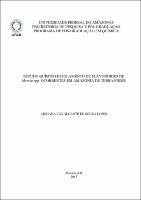| ???jsp.display-item.social.title??? |


|
Please use this identifier to cite or link to this item:
https://tede.ufam.edu.br/handle/tede/6365| ???metadata.dc.type???: | Dissertação |
| Title: | Estudo químico e isolamento de flavonoides Myrcia spp. ocorrentes em Amazônia de terra firme |
| ???metadata.dc.creator???: | Lopes, Adriana Cavalcante de Souza  |
| ???metadata.dc.contributor.advisor1???: | Machado, Marcos Batista |
| ???metadata.dc.contributor.referee1???: | Corrêa, Geone Maia |
| ???metadata.dc.contributor.referee2???: | Pinheiro, Maria Lúcia Belém |
| ???metadata.dc.description.resumo???: | Myrtaceae constitui-se uma das maiores e mais importantes famílias de Angiospermas da flora brasileira. Representantes desta família estão distribuídos nos diferentes biomas brasileiros. Myrcia constitui-se um dos maiores gêneros pertencentes à família Myrtaceae em numero de espécies e estudos químicos e biológicos. Estudos químicos de Myrcia spp. revelaram a presença de substâncias do tipo terpênica, fenólica e flavonoídica, as quais são responsáveis por diversas atividades químicas e biológicas. Este trabalho objetivou descrever o estudo químico de M. bracteata, M. citrifolia e M. fenestrata coletadas na Reserva Florestal Adolpho Ducke em Manaus (AM), bem como avaliar os potenciais antioxidante e hipoglicemiante dos extratos, frações e substâncias isoladas. Os fracionamentos por CLAE do extrato em acetato de etila dos caules e das folhas de M. bracteata resultaram no isolamento de quatro flavonoides glicosilados. Esses foram caracterizados, principalmente, por RMN e EM, como sendo duas dihidroflavonas (naringenina-7-O-b-glicosídeo e eriodictiol-7-O-b- glicosídeo), um dihidroflavonol (astilbina) e um flavonol (quercitrina). As Análises de Variância dos resultados de capacidade sequestrante do radical livre DPPH• revelaram que os extratos não aquosos das três espécies de Myrcia apresentaram os menores valores de CS50% (entre 37-51 %). Dentre esses extratos, os etanólicos de folhas e de caules de M. bracteata apresentaram sinais nos espectros de RMN de 1H característicos de substâncias flavonoídicas. O extrato aquoso sequencial das folhas de M. bracteata (MBFpba) e a naringenina-7-O-b- glicosídeo apresentaram efeitos inibitórios da atividade enzimática da a-glicosidase de Saccharomyces cerevisiae em 20,60±0,08 e 23,27±1,86 %, respectivamente. O extrato aquoso direto das folhas de M. fenestrata (MFFa) apresentou resposta inibitória frente à enzima a- glicosidase de intestino de ratos, cujo valor é 55±3%. Portanto, a espécie M. bracteata evidenciou ser uma fonte de flavonoides com atividades antioxidante e hipoglicemiante, dos quais três ainda não foram descritos no gênero e na família. Portanto, este trabalho contribui com o conhecimento da química de produtos naturais de matrizes vegetais da Amazônia. |
| Abstract: | Myrtaceae constitutes one of the largest and most important Angiosperm families of the Brazil flora and is concentrated in a single tribe: Myrteae (three sub-tribes: Myrciinae, Eugeniinae, and Myrtinae). Species of this family have been distributed in almost all brazilian biomes. The Myrcia spp. constitutes one of the largest genus belonging to Myrtaceae in number species and chemical and biological studies. These chemical studies of Myrcia spp. have revealed the presence of terpenes, phenolics, and flavonoids, which are responsible for several chemical and biological activities. This dissertation describe the chemical study of Myrcia bracteata, M. citrifolia, and M. fenestrata collected in the Reserva Florestal Adopho Ducke, Manaus (AM), as well as evaluates the antioxidant and hypoglycemic potentials of the extracts, fractions, and isolated compounds. The HPLC fractionation of the stems and leaves ethyl acetate extract from Myrcia bracteata had resulted in the isolation of four glycosylated flavonoids. These were characterized, particularly by NMR and MS, as two dihydroflavones (naringenin-7-O-glucoside and eriodictyol-7-O-glucoside), one dihydroflavonol (astilbin) and one flavanol (quercitrin). The ANOVA of the results sequestering ability of free radical DPPH• has revealed that the non-aqueous extracts of three species of Myrcia (except the leaves aqueous extract of M. fenestrata) have the lowest values of CS50 (between 37-51%). Among these extracts, the leaves and stems ethanol extracts of M. bracteata have shown signs of the flavonoid hydrogens type in the 1H NMR spectra. The sequential aqueous extract of M. bracteata and naringenin-7-O-glucoside have exhibit inhibitory effects of a-glucosidase enzyme activity by Saccharomyces cerevisiae of 20.60 ± 0.08 and 23.27 ± 1.86%, respectively. The leaves aqueous direct extract from Myrcia fenestrata was the only sample that showed inhibitory response against the a-glucosidase enzyme of the intestine of rats, whose value is 55 ± 3%. Therefore, the species M. bracteata shows a source of the antioxidant and hypoglycemic flavonoids, among which three were not yet described on genus and family. Therefore, this work has contributed to the knowledge of the Chemistry of Natural Products from plants of the Amazônia bioma. |
| Keywords: | Myrcia bracteata Antioxidante M. citrifolia M. fenestrata Hipoglicemiante Flavonoides Fenólicos |
| ???metadata.dc.subject.cnpq???: | CIÊNCIAS EXATAS E DA TERRA: QUÍMICA |
| Language: | por |
| ???metadata.dc.publisher.country???: | Brasil |
| Publisher: | Universidade Federal do Amazonas |
| ???metadata.dc.publisher.initials???: | UFAM |
| ???metadata.dc.publisher.department???: | Instituto de Ciências Exatas |
| ???metadata.dc.publisher.program???: | Programa de Pós-graduação em Química |
| Citation: | LOPES, Adriana Cavalcante de Souza. Estudo químico e isolamento de flavonoides Myrcia spp. ocorrentes em Amazônia de terra firme. 2015. 126 f. Dissertação (Mestrado em Química) - Universidade Federal do Amazonas, Manaus, 2015. |
| ???metadata.dc.rights???: | Acesso Aberto |
| ???metadata.dc.rights.uri???: | http://creativecommons.org/licenses/by-nc-nd/4.0/ |
| URI: | https://tede.ufam.edu.br/handle/tede/6365 |
| Issue Date: | 29-Oct-2015 |
| Appears in Collections: | Mestrado em Química |
Files in This Item:
| File | Description | Size | Format | |
|---|---|---|---|---|
| Dissertação_AdrianaLopes_PPGQ.pdf | 14.93 MB | Adobe PDF |  Download/Open Preview |
This item is licensed under a Creative Commons License





